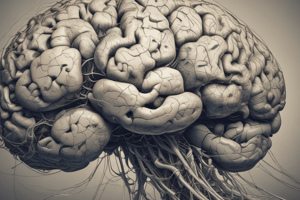Podcast
Questions and Answers
What is a primary reason some individuals experience a small central region of blindness?
What is a primary reason some individuals experience a small central region of blindness?
- Only having functioning rods in low light conditions (correct)
- Low retinal sensitivity in bright light
- Increased cone density in the retina
- Absence of the fovea
What role does age play in the remapping of the visual cortex after retinal lesions?
What role does age play in the remapping of the visual cortex after retinal lesions?
- Age does not affect remapping at all
- Younger individuals can remap better if lesions occur later
- Congenital deficits promote remapping more effectively than acquired lesions (correct)
- Older individuals have enhanced remapping capabilities
Which area of the retina is primarily composed of cones and is crucial for central vision?
Which area of the retina is primarily composed of cones and is crucial for central vision?
- Periphery
- Optic disc
- Macula
- Fovea (correct)
What happens in the visual cortex of individuals who have had a hole since birth?
What happens in the visual cortex of individuals who have had a hole since birth?
How does retinal sensitivity change under low light conditions in relation to the fovea?
How does retinal sensitivity change under low light conditions in relation to the fovea?
What is the primary purpose of inflating the brain during mapping studies?
What is the primary purpose of inflating the brain during mapping studies?
In the context of lateralisation, which hemisphere receives visual information from the left side of both eyes?
In the context of lateralisation, which hemisphere receives visual information from the left side of both eyes?
What was a significant limitation in Henschen's 1896 examination of brain injuries?
What was a significant limitation in Henschen's 1896 examination of brain injuries?
Damage to which part of the occipital lobe primarily affects vision in the upper visual field?
Damage to which part of the occipital lobe primarily affects vision in the upper visual field?
As damage occurs more anterior in the brain, which type of vision is more affected?
As damage occurs more anterior in the brain, which type of vision is more affected?
How do naturally occurring lesions provide insight into brain mapping?
How do naturally occurring lesions provide insight into brain mapping?
What type of model did Roger Tootell utilize to study the visual cortex?
What type of model did Roger Tootell utilize to study the visual cortex?
What is the significance of injecting a radioactive agent in animal studies of the visual cortex?
What is the significance of injecting a radioactive agent in animal studies of the visual cortex?
What does it imply if damage moves anteriorly in the brain regarding visual function?
What does it imply if damage moves anteriorly in the brain regarding visual function?
What effect do small, survivable lesions have on the mapping of the visual cortex?
What effect do small, survivable lesions have on the mapping of the visual cortex?
What is the role of single unit recordings in the study of the visual system?
What is the role of single unit recordings in the study of the visual system?
What area of the brain is primarily associated with color perception?
What area of the brain is primarily associated with color perception?
Which technique measures metabolic activity in the brain using radioactive oxygen?
Which technique measures metabolic activity in the brain using radioactive oxygen?
What occurs when a lesion affects specific visual areas?
What occurs when a lesion affects specific visual areas?
What does the term 'hypercolumn' refer to in visual processing?
What does the term 'hypercolumn' refer to in visual processing?
Which visual area surrounds the primary visual cortex?
Which visual area surrounds the primary visual cortex?
How does eccentricity affect brain processing in the primary visual cortex?
How does eccentricity affect brain processing in the primary visual cortex?
What does fMRI measure in relation to visual stimuli?
What does fMRI measure in relation to visual stimuli?
What happens during visual mapping using PET when a stimulus is presented?
What happens during visual mapping using PET when a stimulus is presented?
In a shape recognition task, which area of the brain showed significant differences when subjected to TMS?
In a shape recognition task, which area of the brain showed significant differences when subjected to TMS?
What is measured to explore the influence of visual attributes such as color and speed?
What is measured to explore the influence of visual attributes such as color and speed?
What does the term 'double dissociation' imply in the context of visual processing?
What does the term 'double dissociation' imply in the context of visual processing?
Flashcards
Central Blind Spot
Central Blind Spot
A small blind spot in the center of the visual field caused by damage or lack of cones in the fovea.
Visual Remapping
Visual Remapping
The ability of the brain to reorganize itself and compensate for missing visual information, especially if the deficit is present from birth.
Macula
Macula
The central region of the retina responsible for sharp, detailed central vision. It contains a high concentration of cone photoreceptor cells.
Cones
Cones
Signup and view all the flashcards
Rods
Rods
Signup and view all the flashcards
Brain Inflation
Brain Inflation
Signup and view all the flashcards
Lateralisation
Lateralisation
Signup and view all the flashcards
Localisation
Localisation
Signup and view all the flashcards
Lesion Studies
Lesion Studies
Signup and view all the flashcards
Scotoma
Scotoma
Signup and view all the flashcards
Retinotopic Map
Retinotopic Map
Signup and view all the flashcards
Autoradiography
Autoradiography
Signup and view all the flashcards
Striate Cortex
Striate Cortex
Signup and view all the flashcards
Plasticity
Plasticity
Signup and view all the flashcards
Multisensory Integration
Multisensory Integration
Signup and view all the flashcards
Post-mortem Anatomy
Post-mortem Anatomy
Signup and view all the flashcards
Ocular Dominance Columns
Ocular Dominance Columns
Signup and view all the flashcards
Electrophysiology
Electrophysiology
Signup and view all the flashcards
Hypercolumn
Hypercolumn
Signup and view all the flashcards
Functional Specialization
Functional Specialization
Signup and view all the flashcards
PET (Positron Emission Tomography)
PET (Positron Emission Tomography)
Signup and view all the flashcards
Primary Visual Cortex (V1)
Primary Visual Cortex (V1)
Signup and view all the flashcards
Visual Field Mapping
Visual Field Mapping
Signup and view all the flashcards
Eccentricity
Eccentricity
Signup and view all the flashcards
Polar Angle
Polar Angle
Signup and view all the flashcards
Holmes Map
Holmes Map
Signup and view all the flashcards
Multiple Visual Fields
Multiple Visual Fields
Signup and view all the flashcards
TMS (Transcranial Magnetic Stimulation)
TMS (Transcranial Magnetic Stimulation)
Signup and view all the flashcards
Double Dissociation
Double Dissociation
Signup and view all the flashcards
Brain Plasticity
Brain Plasticity
Signup and view all the flashcards
Study Notes
Brain Inflation and Visual Mapping
- Brain inflation reveals the surface area of the folded brain, crucial for fitting its size within the skull.
- Folding maximises surface area to accommodate complex neural networks.
Lateralization
- Information from the left visual field (LVF) lands on the right hemisphere and vice versa.
- Information from the left side of each eye ends up in the right hemisphere, and vice versa.
Localization: Historical Approaches
- Henschen (1896) used perimetry and post-mortem anatomy to study visual field deficits.
- Issues with widespread pathology made it difficult to pinpoint specific brain regions affected.
- Damage to the lower part of the occipital lobe affects the lower visual field.
- Small lesions in the occipital lobe, like those caused by bullets, are valuable for mapping specific visual field deficits.
- Projectile damage studies provided valuable information on the impact of occipital damage.
- The Holmes Visual Field Map demonstrated that lesions anteriorly (forward) cause peripheral vision impairment, while posteriorly (back) cause central vision problems.
- Lesions progressively forward in the brain cause vision damage that progressively affects peripheral vision.
- Lesions progressing from lower parts of the brain to higher regions affecting visual fields like a clock.
- Naturally occurring lesions in the brain are also a valuable way of studying these mapping effects.
Animal Models: Exquisite Detail
- Single-unit recordings in animal models provide precise detail of neural responses.
- Toottle's work presented visual stimuli and studied activity in visual cortex of a flattened brain.
- Retinotopic maps are preserved across the striate cortex (V1) of the brain.
Post-Mortem Anatomy in Humans
- Post-mortem anatomy allows for detailed study in humans, often employing one eye in studies related to eye loss.
- Flattening of the brain reveals details and allows researchers to observe columns of brain cells, essential features in brain function.
- Occular dominance columns can be studied via post-mortem anatomy.
Functional Modules: Electrophysiology
- A hypercolumn is a functional module in V1, central to primary visual cortex.
- It processes information from both eyes.
- Orientation preference in receptive fields of neurons is an important parameter in understanding how different areas and cells in the primary visual cortex function.
Summary: Visual Mapping Techniques
- Lesion studies contribute insight into visual area specialization.
- Single-unit electrophysiology provides fine-grained detail on neural processing in layers, columns, and blobs within the primary visual cortex (V1).
- Functional specialisation at a finer scale than lesion studies.
PET (Positron Emission Tomography)
- PET provides rough mapping of human visual systems and reveals functional specializations within these regions.
- PET measures metabolic activity in the human brain.
- Radioactive oxygen is used to label water molecules.
Visual Mapping with PET
- PET is used to study cerebral blood flow in visual perception.
- Baseline blood flow measurements are subtracted from those obtained during targeted visual stimuli like checkerboards.
- The resulting activity maps show increased activity in the occipital lobe related to stimulus location.
- Central vision is represented more interiorly/deeply compared to peripheral vision in the brain maps.
Color and Motion Processing
- V4 is a region specialized for processing color.
- Brain regions are specialized to process motion.
fMRI (functional Magnetic Resonance Imaging) Visual Field Mapping
- fMRI is used to map visual field eccentricity, measuring activity associated with visual stimuli at various locations, moving from the central fixation point.
- Activity patterns in the occipital lobe reflect eccentricities or different locations/positions in the visual field.
fMRI Visual Field Mapping - Polar Angle
- Changes in stimuli polar angle from central fixation point are studied.
- Activity maps show a relationship between visual stimulus angle and active brain regions.
Primary Visual Cortex: Holmes Maps
- Many maps exist within the cortex to encode different aspects of the visual system and processing.
- The brain dedicates more processing to areas where we see well.
Multiple Visual Fields
- Experimentally measure visual attributes (e.g., color, speed) and their impact on different specialized areas within the cortex.
Shape Processing: TMS (Transcranial Magnetic Stimulation)
- TMS was used to identify functional specializations in shape perception (compared to visual orientation) in specific visual cortices (V1,V2).
Double Dissociation
- Double dissociation between the processing area for spatial and shape attributes in the visual cortex identified within this research.
Reshaping Visual Maps
- Retinal damage related to visual perceptual abnormalities, and related cortical plasticity.
- Visual remapping is shown to occur in particular situations like birth defects related to vision.
- Age plays a key role in the type remapping of visual information.
Anatomical Imaging
- Anatomical imaging is used to study changes in the brain related to visual abnormalities.
Corresponding Information
- Study results relating to visual mapping with different forms of cortical imaging and neural analysis were used to compare.
Studying That Suits You
Use AI to generate personalized quizzes and flashcards to suit your learning preferences.



